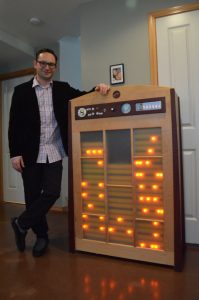Electrical engineer Simon A.J. Winder has spent the past six years perfecting this giant calculator, inspired by early computers, that can calculate square roots using solely electromechanical relays.
Initially Winder wanted to build a “pocket calculator” using relays and a Nixie tube display, but he discovered that this sort of calculator would require too many relays to carry out addition, subtraction, multiplication, and division processes. (Winder estimates he would have needed about 800 relays.) So he decided to build a machine that would only calculate square roots.

According to Winder’s project blog:
One of the things that I like about relays is that they are slow and noisy, and if you add lights to each one, as I have done, then you can easily see how these devices are being used, at least in terms of a pattern of operation over time. This is in contrast to modern computers where the operations happen in microscopic circuits in a manner which is far removed from human senses. Watching a slow relay computer figure out square roots seems to bring this digital world back into human consciousness.
Winder created a circuit that could transfer information from one set of relays to another based on a single “clock pulse,” allowing a user to make a synchronous counter. That’s what made the whole project possible. His creation enabled him to build counters and memory circuits so that storing and transferring the information was simple enough.
Once he ironed out the basics, Winder wrote a simulation of the square root operation in C-sharp on his computer, making sure he had the “necessary registers and operations in place to carry out a square root operation using 8 digit floating point precision.” At this point he figured out how realistic a calculator of this nature would be to create, computationally speaking.

He then built printed circuit boards to hold the relays, including an area on the back for manual wiring. The calculator’s display includes eight Russian IN-16 nixie tubes and anodes that connect via resistor to a high voltage supply. The cathodes get shorted to ground via relay contacts, depending on which of the ten digits is required to illuminate. Winder even includes a decimal point that lights up!
Winder’s documents and specifics can be found here.
Winder will be making an appearance at the upcoming Seattle Maker Faire later this month where he will show off some of his technology.
Watch the calculator in action below.
Story and video via Simon Winder.

